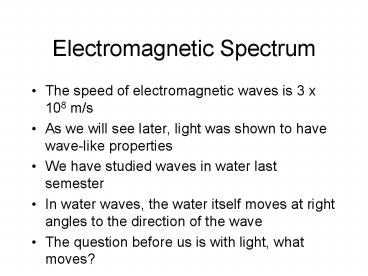Electromagnetic Spectrum - PowerPoint PPT Presentation
1 / 18
Title: Electromagnetic Spectrum
1
Electromagnetic Spectrum
- The speed of electromagnetic waves is 3 x 108 m/s
- As we will see later, light was shown to have
wave-like properties - We have studied waves in water last semester
- In water waves, the water itself moves at right
angles to the direction of the wave - The question before us is with light, what moves?
2
Electromagnetic Spectrum
- Maxwell argued that light must be an
electromagnetic wave - Hertz was able to produce EM waves using a spark
gap with oscillating electrons at a frequency of
about 109 vibrations/second - These waves were shown to have a velocity of 3 x
108 m/s - They could be reflected, refracted and showed
interference, just like light
3
Electromagnetic Spectrum
- Long before people knew what light was, by doing
interference measurements, people showed that
visible light had wavelengths ranging from 4 x
10-7 m to 7.5 x 10-7 m - Recall that f?c where c is the velocity of light
- That means the frequencies of visible light range
from 4 x 1014 Hz and 7.5 x 1014 Hz
4
Electromagnetic Spectrum
- So, we know about two ranges of frequencies or
wavelengths of EM radiation - What about others?
- We now know that there is a very large range of
frequencies and wavelengths of EM radiation in
nature - We can display them in a chart
5
Electromagnetic Spectrum
We can produce many of these ranges by
accelerating electrons, whether in an antenna or
by rapidly stopping moving electrons as in an
x-ray tube.
6
Measure the Speed of Light
7
Energy in EM Waves
- W have determined that the energy density in an
electric field is ?0E2/2 - We also learned that the energy density in a
magnetic field is B2/2?0 - So, the energy per unit volume in space
containing an EM wave is
8
Energy in EM Waves
- We can do some manipulations using some of the
relationships we have derived earlier to get some
other forms for the energy density - The energy is shared equally between the electric
and magnetic fields
9
Poynting Vector
- We can look at the energy transported across unit
area per unit time by an EM wave
10
Poynting Vector
11
Poynting Vector
12
Poynting Vector
13
Information Transmission
- We can use EM waves to carry information by a
technique known as modulation - We are going to add two signals together
- Recall when we added waves together last fall,
the resulting wave is just formed by addition of
amplitudes - This is known as amplitude modulation
14
Information Transmission
This is amplitude modulation and is used for AM
Radio (530-1600 kHz) and for TV pictures
15
Information Transmission
This is frequency modulation and is used for FM
Radio (88-108 MHz) and for TV audio
16
Information Transmission
Here the antenna is responding to the electric
field portion of the EM wave.
17
Information Transmission
Here the antenna is responding to the magnetic
field portion of the EM wave.
18
Information Transmission
Tune the radio by adjusting the LC circuit to
match the frequency of the incoming EM wave.































